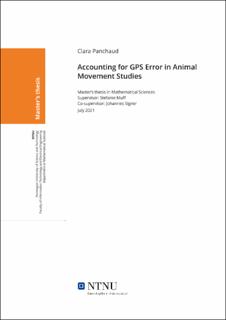| dc.description.abstract | Animal movement studies aim to understand animal behavior by analyzing data consisting of locations visited by the animals, often collected by GPS collars. As the positioning technologies have been improving quickly over the last decades, new opportunities have arisen in animal movement studies, accompanied by challenges. In this thesis, we focus on the issue of GPS error in the animal positions collected by GPS collars. We propose to use an existing error correction method called Simulation Extrapolation, or SIMEX, in order to understand GPS error in animal movement studies, and try to account for them.
We start with a review of the common frameworks used in animal movement studies, which are Resource-Selection Functions (RSFs) and Step-Selection Functions (SSFs), with a focus on the latter. We describe these methods and their challenges, as well as their associated models. An SSF is commonly formulated as a conditional logistic model, but we also recall that it can be reformulated as a Poisson model. Furthermore, we review the need for random effects in both formulations. To display the differences between the existing methods to fit an SSF, we apply them to a dataset on lynx. Finally, we introduce the use of SIMEX in animal movement studies with simulations as well as a case study on a dataset of sandhill cranes.
The analysis on the lynx dataset revealed that the Poisson reformulation with random effects is generally the preferred model. Furthermore, the simulations showed that SIMEX is an in- teresting method to understand GPS error and reduce bias in the estimated parameters. The crane analysis further emphasized the conclusion from the simulations, even though some lim- itations of SIMEX appeared. Overall, the results suggested that GPS error is an issue that should not be ignored in animal movement studies, and that SIMEX is an easy and intuitive approach to consider as a potential solution to the issue. | |
